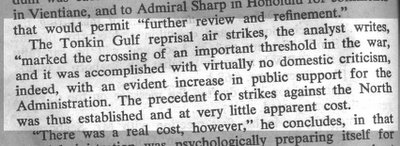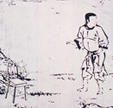Operation Plan 34-A
The intelligence community was pleased with President Lyndon Baines Johnson. Although their activities in Southeast Asia ultimately destroyed his presidency, he was not directly targeted. He was, so to speak, collateral damage.
A few details help place the Johnson administration in proper context. In August of 1964, Americans were enraged after North Vietnamese P.T. boats twice attacked a U.S. ship in international waters. Within days, the Tonkin Resolution gave Johnson significant, new war powers. Cam Rahn Bay was chosen as the site of a naval installation. A company in Texas, Brown and Root, got the contract to dredge the bay. When the horrors at Con Son prison were exposed, Brown and Root got the contract to build a new prison. Kellogg, Brown and Root, today a subsidiary of Halliburton, is building a new prison in Iraq and a new facility at Guantanamo Bay, Cuba.
Nearly a decade after the Tonkin incidents, the Pentagon Papers revealed that the Resolution had been written by “Administration” figures, otherwise unidentified, months in advance. President Johnson was able to respond quickly with air strikes because the targets had already been selected.

But there were no attacks in the Gulf of Tonkin. The incidents were the result of Operation Plan 34-A, set in motion in December of 1963. 34-A included commando raids against North Vietnam, bombing runs of U.S. planes flown by Thai pilots, kidnappings, and so on. The goal was to provoke an attack by the North Vietnamese or to create the appearance of such an attack.

In fact, the U.S. recruited Vietnamese commandos for Op Plan 34-A. Many were captured and held prisoner for years. Eventually, surviving commandos brought a suit for compensation. In 1996, they dropped the suit in exchange for $12 million from the Defense Department. The measure was sponsored by a decorated war veteran, Senator John Kerry. The agreement also provided money for participants of Op Plan 35-Alpha. Nobody in Washington wanted to see our former agents testifying in court about the hoax that stampeded the country to war. And in anticipation of your question, I have no idea what 35-Alpha was.
On October 31, 2005, The New York Times ran a lengthy article about a classified National Security Agency study concerning the Gulf of Tonkin attacks. The study found that intercepted Vietnamese transmissions connected to the Tonkin incidents were falsified in a round-about fashion. According to the study, original translation errors and other mistakes created a misleading picture. Mid-level personnel, otherwise unidentified, recognized the problem but did nothing to correct it because they favored military action. According to the study, President Johnson and top officials at the N.S.A. did not know about the deception. Stop me when this starts to sound familiar.
The Bush administration has kept the full N.S.A. study secret, lest the public recognizes unflattering parallels between pre-war intelligence in Vietnam and pre-war intelligence in Iraq.
____________________
A few details help place the Johnson administration in proper context. In August of 1964, Americans were enraged after North Vietnamese P.T. boats twice attacked a U.S. ship in international waters. Within days, the Tonkin Resolution gave Johnson significant, new war powers. Cam Rahn Bay was chosen as the site of a naval installation. A company in Texas, Brown and Root, got the contract to dredge the bay. When the horrors at Con Son prison were exposed, Brown and Root got the contract to build a new prison. Kellogg, Brown and Root, today a subsidiary of Halliburton, is building a new prison in Iraq and a new facility at Guantanamo Bay, Cuba.
Nearly a decade after the Tonkin incidents, the Pentagon Papers revealed that the Resolution had been written by “Administration” figures, otherwise unidentified, months in advance. President Johnson was able to respond quickly with air strikes because the targets had already been selected.

But there were no attacks in the Gulf of Tonkin. The incidents were the result of Operation Plan 34-A, set in motion in December of 1963. 34-A included commando raids against North Vietnam, bombing runs of U.S. planes flown by Thai pilots, kidnappings, and so on. The goal was to provoke an attack by the North Vietnamese or to create the appearance of such an attack.

In fact, the U.S. recruited Vietnamese commandos for Op Plan 34-A. Many were captured and held prisoner for years. Eventually, surviving commandos brought a suit for compensation. In 1996, they dropped the suit in exchange for $12 million from the Defense Department. The measure was sponsored by a decorated war veteran, Senator John Kerry. The agreement also provided money for participants of Op Plan 35-Alpha. Nobody in Washington wanted to see our former agents testifying in court about the hoax that stampeded the country to war. And in anticipation of your question, I have no idea what 35-Alpha was.
On October 31, 2005, The New York Times ran a lengthy article about a classified National Security Agency study concerning the Gulf of Tonkin attacks. The study found that intercepted Vietnamese transmissions connected to the Tonkin incidents were falsified in a round-about fashion. According to the study, original translation errors and other mistakes created a misleading picture. Mid-level personnel, otherwise unidentified, recognized the problem but did nothing to correct it because they favored military action. According to the study, President Johnson and top officials at the N.S.A. did not know about the deception. Stop me when this starts to sound familiar.
The Bush administration has kept the full N.S.A. study secret, lest the public recognizes unflattering parallels between pre-war intelligence in Vietnam and pre-war intelligence in Iraq.
____________________


<< Home